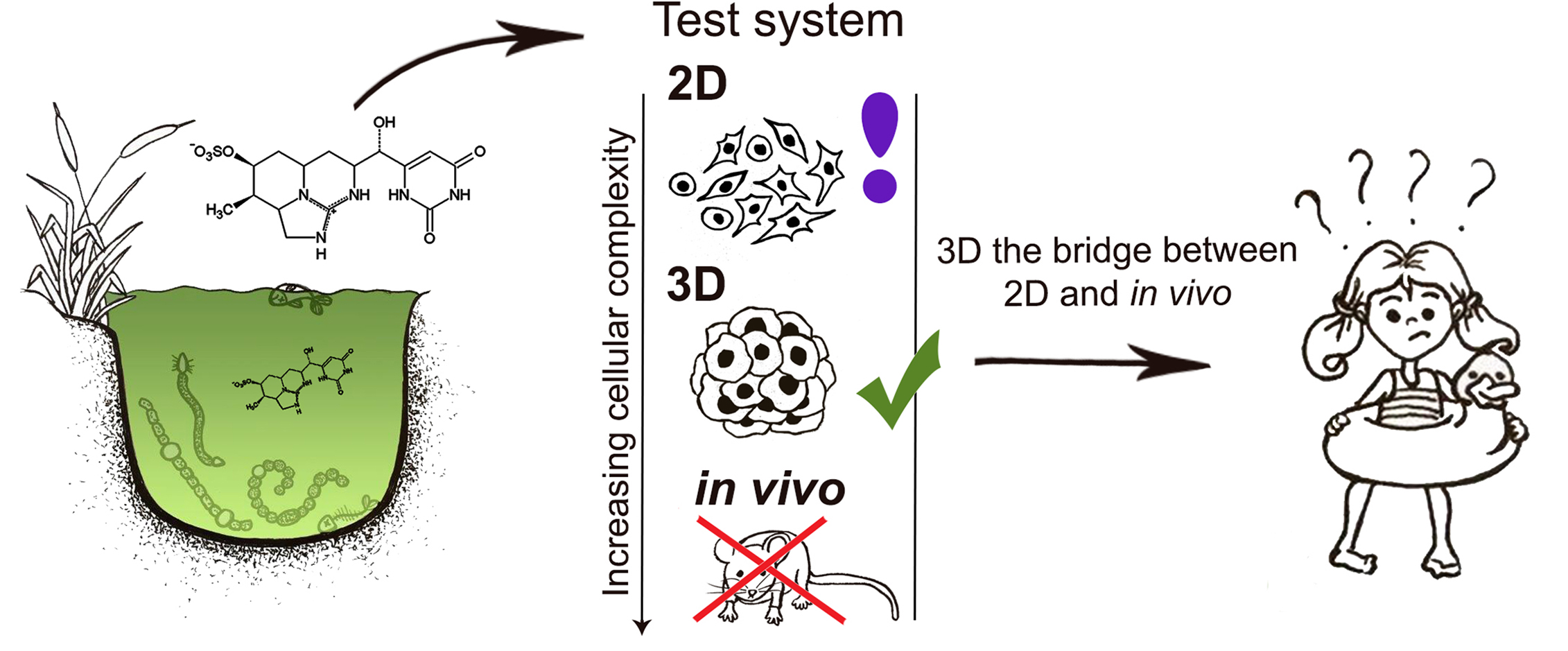NIB
The purpose of the investment project BTH-NIB is the assurance of the appropriate infrastructural conditions for the use of research and developmental opportunities in the fields of operation of the NIB.
Play Video About project Publication
Assist. Prof. Dr. Alja Štern
Working place: Scientific Associate
Telephone number: +386 (0)59 23 28 64
Email: alja.stern@nib.si
Department: Department of Genetic Toxicology and Cancer Biology
I am among those who think that science has great beauty.
– Marie Curie

For me, science is all of that and more. It is a perspective, a way of life. It is the way to understanding and the way to a better future. I want to understand effects, processes, interactions. I want to figure out the unknown. The main topic of my research is toxicology, particularly genetic toxicology. I research toxic and genotoxic effects of natural toxins, pollutants, pharmaceuticals and many other different chemicals, on mammalian cells, with the goal to understand the mechanisms of their action and evaluate the risk of chronic exposure to these compounds for human health. Complementary, I study the chemoprotective effects of selected chemicals against toxic and genotoxic assaults caused by carcinogens and the mechanism of their chemoprotective action. I’m also involved in the development and optimization of new advanced in vitro test systems and methodologies for studying adverse effects and identification of genotoxic chemicals and chemical carcinogens, improving the physiological relevance and predictivities compared to commonly applied test systems, creating more reliable data for the human health hazard assessment.
·
· SICRIS
· ORCiD
Genotoxicity of cyanobacterial toxins
I studied the genotoxic effects of different cyanobacterial toxins for my PhD, focusing on the cyanobacterial alkaloid cylindrospermopsin produced mainly by Cylindrospermopsis raciborskii, increasingly occurring in fresh surface waters around the world due to climate change and water eutrophication. Of great interest for me is also studying more realistic exposure scenarios – the influence of complex mixtures of cyanotoxins and other pollutants and on mammalian cells in vitro, at the cellular level, to understand their complex interactions.
· THESIS

Selected publications:
- ŠTERN, Alja, ROTTER, Ana, NOVAK, Matjaž, FILIPIČ, Metka, ŽEGURA, Bojana. Genotoxic effects of the cyanobacterial pentapeptide nodularin in HepG2 cells. Food and chemical toxicology. 2019, vol. 124, str. 349-358. ISSN 0278-6915. DOI: 10.1016/j.fct.2018.12.019. [COBISS.SI-ID 4930383]
- ŠTERN, Alja, FILIPIČ, Metka, GORENC, Irena, ŽEGURA, Bojana. The influence of cylindrospermopsin on oxidative DNA damage and apoptosis induction in HepG2 cells. Chemosphere. [Print ed.]. 2013, vol. 92, issue 1, str. 24-30. ISSN 0045-6535. DOI: 10.1016/j.chemosphere.2013.03.023. [COBISS.SI-ID 2774095]
- ŠTERN, Alja, FILIPIČ, Metka, NOVAK, Matjaž, ŽEGURA, Bojana. Double strand breaks and cell-cycle arrest induced by the cyanobacterial toxin cylindrospermopsin in HepG2 cells. Marine drugs. 2013, vol. 11, no. 8, str. 3077-3090. ISSN 1660-3397. http://www.mdpi.com/1660-3397/11/8/3077, DOI: 10.3390/md11083077. [COBISS.SI-ID 2856527] PDF
- ŠTERN, Alja, FILIPIČ, Metka, ŽEGURA, Bojana. Cylindrospermopsin induced transcriptional responses in human hepatoma HepG2 cells. Toxicology in vitro. 2013, vol. 27, no. 6, str. 1809-1819. ISSN 0887-2333. DOI: 10.1016/j.tiv.2013.05.012. [COBISS.SI-ID 2805327]
- ŠTERN, Alja, FILIPIČ, Metka, ŽEGURA, Bojana. Genotoxic effects of the cyanobacterial hepatotoxin cylindrospermopsin in the HepG2 cell line. Archives of toxicology. 2011, vol. 85, no. 12, str. 1617-1626. ISSN 0340-5761. http://dx.doi.org/10.1007/s00204-011-0716-z, DOI: 10.1007/s00204-011-0716-z. [COBISS.SI-ID 2385231] PDF
- ŽEGURA, Bojana, ŠTERN, Alja, FILIPIČ, Metka. Genotoxicity and potential carcinogenicity of cyanobacterial toxins-a review. Mutation research. Reviews in mutation research. 2011, vol. 727, issues 1-2, str. 16-41. ISSN 1383-5742. http://dx.doi.org/10.1016/j.mrrev.2011.01.002, DOI: 10.1016/j.mrrev.2011.01.002. [COBISS.SI-ID 2340943]
- BITTNER, Michal, ŠTERN, Alja, SMUTNA, Marie, HILSCHEROVA, Klara, ŽEGURA, Bojana. Cytotoxic and genotoxic effects of cyanobacterial and algal extracts-microcystin and retinoic acid content. Toxins : Elektronski vir. 2021, vol. 13, no. 2, str. 1-15. ISSN 2072-6651. https://www.mdpi.com/2072-6651/13/2/107. [COBISS.SI-ID 49665283] PDF
- HERCOG, Klara, ŠTERN, Alja, MAISANABA HERNÁNDEZ, Sara, FILIPIČ, Metka, ŽEGURA, Bojana. Plastics in cyanobacterial blooms - genotoxic effects of binary mixtures of cylindrospermopsin and bisphenols in HepG2 cells. Toxins : Elektronski vir. 2020, vol. 12, iss. 4, str. 1-19, ilustr. ISSN 2072-6651. https://www.mdpi.com/2072-6651/12/4/219. [COBISS.SI-ID 40541189] PDF
Chemoprotective chemicals
Studying potential chemoprotective agents, especially diet and nutrition related phytochemicals, goes hand in hand with the study of genotoxic and carcinogenic substances with regard to the prevention of their hazardous and deleterious effects. Nutrition and diet are fundamentally involved in human cancer etiology and prevention. The human diet is highly complex and versatile, containing numerous potentially mutagenic and carcinogenic ingredients, compounds, and contaminants, as well as various antioxidants and potentially chemoprotective and anticarcinogenic bioactive chemicals, which could be widely used in cancer prevention.
Selected publications:
- ŠTERN, Alja, FURLAN, Veronika, NOVAK, Matjaž, ŠTAMPAR, Martina, KOLENC, Zala, KORES, Katarina, FILIPIČ, Metka, BREN, Urban, ŽEGURA, Bojana. Chemoprotective effects of xanthohumol against the carcinogenic mycotoxin aflatoxin B1. Foods. 9 June 2021, vol. 10, iss. 6, str. 1-19, ilustr. ISSN 2304-8158. DOI: 10.3390/foods10061331. [COBISS.SI-ID 66572035]] PDF
Development of new advanced test systems and methodologies in genetic toxicology
Recently my research topic has gravitated towards the development of new advanced test systems and methodologies, for the use in genetic toxicology. The reason behind the shift is the lack of accuracy of the in vitro test systems and methodologies currently in use and their poor predictability for human exposure. Because of these disadvantages of classical in vitro test systems, in vivo experiments on rodents are still considered the golden standard for the evaluation of the carcinogenic potential of chemicals. Experiments on animals are ethically questionable, and highly time and resource consuming and are therefore to be reduced, refined and replaced by suitable new improved in vitro systems, with high priority and importance.

Selected publications:
- HERCOG, Klara, ŠTAMPAR, Martina, ŠTERN, Alja, FILIPIČ, Metka, ŽEGURA, Bojana. Application of advanced HepG2 3D cell model for studying genotoxic activity of cyanobacterial toxin cylindrospermopsin. Environmental pollution. [Print ed.]. Oct. 2020, vol. 265, pt. b, str. 1-11, ilustr. ISSN 0269-7491. DOI: 10.1016/j.envpol.2020.114965. [COBISS.SI-ID 19219971]


 Scope of NIB's accreditation is given in the Annex to the accreditation certificate and in the List of accredited methods for detection of GMOs and microorganisms – plant pathogens
Scope of NIB's accreditation is given in the Annex to the accreditation certificate and in the List of accredited methods for detection of GMOs and microorganisms – plant pathogens 
